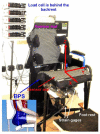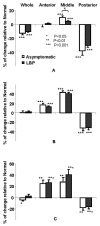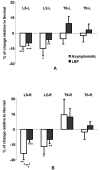Biomechanical effects of sitting with adjustable ischial and lumbar support on occupational low back pain: evaluation of sitting load and back muscle activity
- PMID: 19193245
- PMCID: PMC2654542
- DOI: 10.1186/1471-2474-10-17
Biomechanical effects of sitting with adjustable ischial and lumbar support on occupational low back pain: evaluation of sitting load and back muscle activity
Abstract
Background: Compared to standing posture, sitting decreases lumbar lordosis, increases low back muscle activity, disc pressure, and pressure on the ischium, which are associated with occupational LBP. A sitting device that reduces spinal load and low back muscle activities may help increase sitting comfort and reduce LBP risk. The objective of this study is to investigate the biomechanical effect of sitting with a reduced ischial support and an enhanced lumbar support (Off-Loading) on load, interface pressure and muscle activities.
Methods: A laboratory test in low back pain (LBP) and asymptomatic subjects was designed to test the biomechanical effect of using the Off-Loading sitting posture. The load and interface pressure on seat and the backrest, and back muscle activities associated with usual and this Off-Loading posture were recorded and compared between the two postures.
Results: Compared with Normal (sitting upright with full support of the seat and flat backrest) posture, sitting in Off-Loading posture significantly shifted the center of the force and the peak pressure on the seat anteriorly towards the thighs. It also significantly decreased the contact area on the seat and increased that on the backrest. It decreased the lumbar muscle activities significantly. These effects are similar in individuals with and without LBP.
Conclusion: Sitting with reduced ischial support and enhanced lumbar support resulted in reduced sitting load on the lumbar spine and reduced the lumbar muscular activity, which may potentially reduce sitting-related LBP.
Figures





Similar articles
-
Sitting with adjustable ischial and back supports: biomechanical changes.Spine (Phila Pa 1976). 2003 Jun 1;28(11):1113-21; discussion 1121-2. doi: 10.1097/01.BRS.0000068243.63203.A8. Spine (Phila Pa 1976). 2003. PMID: 12782977
-
Biomechanical evaluation of a novel wheelchair backrest for elderly people.Biomed Eng Online. 2015 Feb 21;14:14. doi: 10.1186/s12938-015-0008-6. Biomed Eng Online. 2015. PMID: 25880921 Free PMC article. Clinical Trial.
-
Influence of trunk muscle co-contraction on spinal curvature during sitting reclining against the backrest of a chair.Electromyogr Clin Neurophysiol. 2008 Nov-Dec;48(8):359-65. Electromyogr Clin Neurophysiol. 2008. PMID: 19097476
-
Sitting biomechanics part I: review of the literature.J Manipulative Physiol Ther. 1999 Nov-Dec;22(9):594-609. doi: 10.1016/s0161-4754(99)70020-5. J Manipulative Physiol Ther. 1999. PMID: 10626703 Review.
-
Differences in lumbar spine intradiscal pressure between standing and sitting postures: a comprehensive literature review.PeerJ. 2023 Oct 19;11:e16176. doi: 10.7717/peerj.16176. eCollection 2023. PeerJ. 2023. PMID: 37872945 Free PMC article. Review.
Cited by
-
The mediating role of physical activity and sedentary behavior in the association between working from home and musculoskeletal pain during the COVID-19 pandemic.Front Public Health. 2022 Dec 2;10:1072030. doi: 10.3389/fpubh.2022.1072030. eCollection 2022. Front Public Health. 2022. PMID: 36530694 Free PMC article.
-
The Short Term Musculoskeletal and Cognitive Effects of Prolonged Sitting During Office Computer Work.Int J Environ Res Public Health. 2018 Aug 7;15(8):1678. doi: 10.3390/ijerph15081678. Int J Environ Res Public Health. 2018. PMID: 30087262 Free PMC article.
-
Objectively measured activity patterns among adults in residential aged care.Int J Environ Res Public Health. 2013 Dec 4;10(12):6783-98. doi: 10.3390/ijerph10126783. Int J Environ Res Public Health. 2013. PMID: 24304508 Free PMC article.
-
A sloped seat wedge can change the kinematics of the lumbar spine of seated workers with limited hip flexion.J Phys Ther Sci. 2014 Aug;26(8):1173-5. doi: 10.1589/jpts.26.1173. Epub 2014 Aug 30. J Phys Ther Sci. 2014. PMID: 25202175 Free PMC article.
-
Evaluation of the effect of different sitting assistive devices in reclining wheelchair on interface pressure.Biomed Eng Online. 2017 Aug 29;16(1):108. doi: 10.1186/s12938-017-0398-8. Biomed Eng Online. 2017. PMID: 28851369 Free PMC article.
References
-
- Biyani A, Andersson G. Low Back Pain: Pathophysiology and Management. Journal of the American Academy of Orthopaedic Surgeons. 2004;12:106–115. - PubMed
Publication types
MeSH terms
Grants and funding
LinkOut - more resources
Full Text Sources
Medical
Miscellaneous

